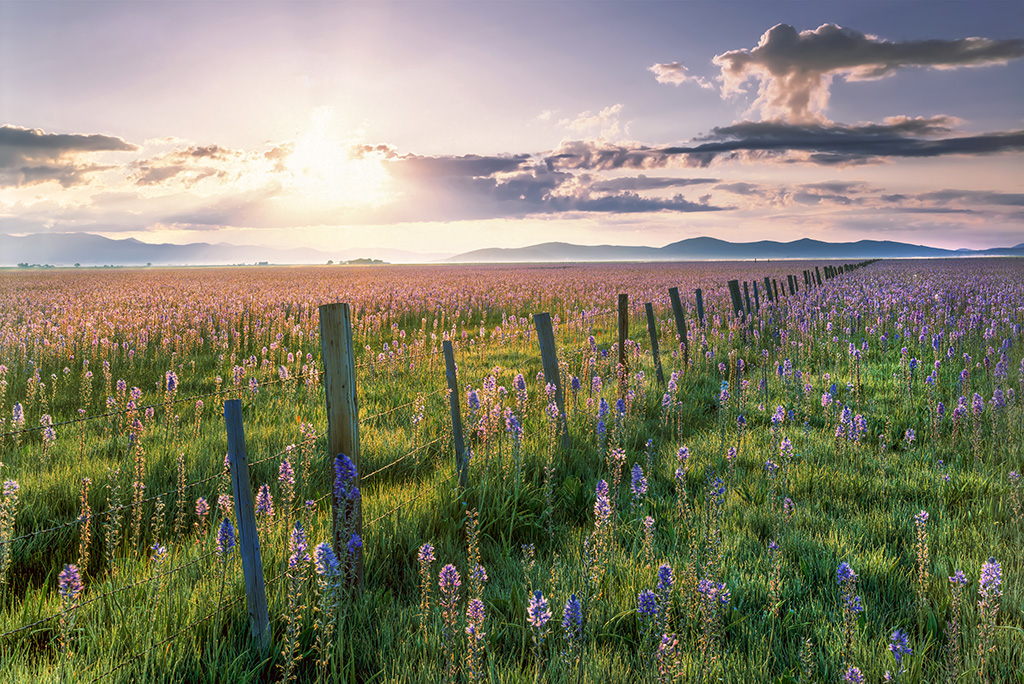“Well, that should make for some good photographs.” I smiled and heartily agreed with another visitor as we gazed on the vast fields of camas lily blooms in south central Idaho’s Camas Prairie Centennial Marsh Wildlife Management Area. A long name but the place isn’t short on beauty. In general, the camas blooms peak around mid-June, and in a good year (usually created by a wet spring), the grassy swamps become acres of purple and blue. Horizon and subdued light can be best for observing the rich colors unique to this species of camas.
During this same time, the refuge becomes alive with the constant chirps, honks, warbles, chitters and trills from thousands of waterfowl that migrate here in spring. Birdwatchers can be fun to listen to as they rattle off names like lesser yellowlegs, least sandpiper, long-billed, dowitcher or maybe a black-need stilt or a phalarope–I had to look up the names to make sure I’m spelling them right. For me, the endless nursery chatter is an amusement in itself. Things start to get a lot quieter around mid-July as the waters recede in summer heat, but it’s still a perfect haunt for local wildlife.
This 3,100-acre refuge is just outside the tiny town of Fairfield (not to be confused with Fairfield, Iowa). Lodging opportunities are said to be “less abundant” in this only city in Camas County. With a population of around 420, less abundant seems appropriate. In the paste, there were a few other town sites in the country, and some of the names like Hill City still show on maps. One of the access routes to the refuge off Highway 20 begins at Hill City by some picturesque grain bins and aging buildings.
A visit will be enriched by learning some history of the region. Camas bulbs were a valuable food source for Native Americans, and a small amount of harvesting still takes place. The bulbs look a little like a small potato and are roasted in coals. I’ve never tasted one, but I hear a bit of salt is helpful. Clearly, it would be a mistake to confuse this species with death camas, a common range plant found in Oregon. The word death in the name tells a story.
Some historical accounts describe Camas Valley and Prairie as a “veritable Eden” with everything in abundance a person needs to live a good life. With poetic prose, a San Francisco newspaper advertised the land as a paradise in about every way possible. In 1862, Tim Goodale announced the opening of a detour off the Oregon Trail. This new route went straight through the prairie, and so-called settling of the area became more exuberant in the later 1800s.
Adjacent refuge lands now consist of farms and ranches with national forests in the higher mountains. Pioneer cabins, grain elevators and old schoolhouses provide more historical context along with character.
The valley population is less now than it was in the early 1990s, and we are fortunate to reap the advantages of those with foresight as they set aside a section for a wildlife and nature preserve.
With an average elevation of 5,000 feet, it’s a high-desert plateau so some chilly winds can blow, even in June. My favorite times of day are early morning and late evening, but calm days can still be perfect for taking the loop drive through the refuge. Access is free. There is one official pullout in the center of the refuge that ends under some large cottonwood trees, and the few hiking trails aren’t well defined or traveled. Watch carefully for the trails; they are great for bird watching, photography or just some leg stretching.
Small breezes make the waist-high camas bend and sway, and many of the birds use them for perches as they go about protecting their territory. From a distance, the acres of rippling blue have been mistake for lakes. William Clark of Lewis and Clark made this mistake in the Columbia Basin and later wrote in his journal how what he saw resembled a lake of fine clear water.
I might get a little good-hearted ribbing for advertising one of Idaho’s hidden gems, but Fairfield is a small town full of friendly people. They host some great events like Camas Lily Days during the first weekend in June. Bloom tours are hosted, Native American traditions are honored, and there are plenty of activities for kids and families.


